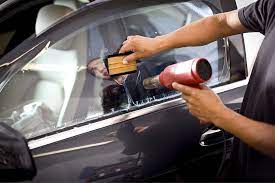Window tinting isn’t just for aesthetics; it’s a practical solution that enhances both style and comfort while driving. From reducing glare and heat to protecting interiors and privacy, switchable film brooklyn ny offer a multitude of benefits. In this comprehensive guide, we delve into the world of window tinting, exploring its advantages, types, regulations, and installation process.
Understanding Window Tinting:
Window tinting involves applying a thin film to the interior or exterior of vehicle windows. This film is typically made of polyester and can vary in thickness and opacity. The tinting process modifies the window’s transparency, reducing the amount of visible light and heat that penetrates the glass.
Advantages of Window Tinting:
- Heat Reduction: Tinted windows help regulate interior temperatures by blocking a significant portion of solar heat, keeping the vehicle cooler and reducing the need for excessive air conditioning.
- Glare Reduction: Tinted films minimize glare from sunlight and headlights, enhancing visibility and reducing eye strain, particularly during daytime and nighttime driving.
- UV Protection: Quality window films block harmful ultraviolet (UV) rays, protecting occupants from skin damage and reducing the fading of interior upholstery and dashboard materials.
- Enhanced Privacy: Tinted windows provide an added layer of privacy, preventing outsiders from easily seeing into the vehicle without significantly impairing visibility from inside.
- Safety and Security: In the event of an accident, window tinting can hold shattered glass together, reducing the risk of injury from flying debris. It also acts as a deterrent against theft by concealing valuable items within the vehicle.
Types of Window Tinting:
- Dyed Film: This type of tinting uses a dye to absorb solar heat and reduce glare. While cost-effective, dyed films may fade over time and offer limited heat rejection.
- Metalized Film: Metalized films incorporate metallic particles to reflect heat and block UV rays. They provide better heat rejection and durability but may interfere with electronic signals and cause a reflective appearance.
- Carbon Film: Carbon-based films offer superior heat rejection, UV protection, and clarity compared to dyed and metalized films. They are less likely to fade or interfere with electronics, making them a popular choice for many drivers.
- Ceramic Film: Considered the premium option, ceramic films utilize ceramic nanoparticles to block heat and UV rays while maintaining excellent visibility and clarity. They are highly durable and do not interfere with electronic signals.
Regulations and Legal Considerations:
Before tinting your windows, it’s crucial to familiarize yourself with local regulations regarding tint darkness and reflectivity. Many jurisdictions have specific laws governing the permissible levels of tint, primarily for safety reasons. Failure to comply with these regulations may result in fines or legal penalties.
Installation Process:
While some DIY enthusiasts may attempt to tint their own windows, professional installation is recommended for optimal results. Trained technicians use specialized tools and techniques to ensure proper alignment, adhesion, and bubble-free application of the tinting film. Additionally, professional installers can provide valuable advice on choosing the right tint for your vehicle and desired level of tint darkness.
Conclusion:
Window tinting offers a host of benefits, from improving comfort and privacy to enhancing the overall aesthetics of your vehicle. By understanding the advantages, types, regulations, and installation process, you can make an informed decision about tinting your windows. Whether you prioritize heat reduction, glare reduction, or UV protection, there’s a window tinting solution to suit your needs and preferences. Invest in window tinting today and enjoy a cooler, more comfortable driving experience.


